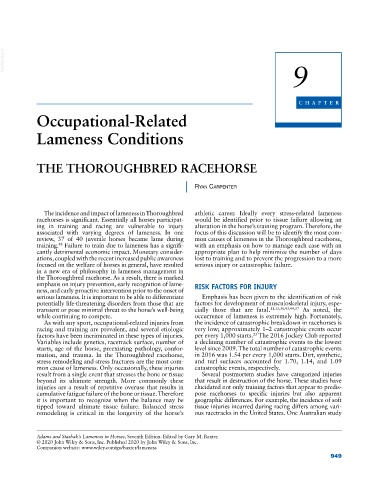Page 983 - Adams and Stashak's Lameness in Horses, 7th Edition
P. 983
VetBooks.ir
9
CHAPTER
Occupational‐Related
Lameness Conditions
THE THOROUGHBRED RACEHORSE
Ryan CaRpenteR
The incidence and impact of lameness in Thoroughbred athletic career. Ideally every stress‐related lameness
racehorses is significant. Essentially all horses participat would be identified prior to tissue failure allowing an
ing in training and racing are vulnerable to injury alteration in the horse’s training program. Therefore, the
associated with varying degrees of lameness. In one focus of this discussion will be to identify the most com
review, 37 of 40 juvenile horses became lame during mon causes of lameness in the Thoroughbred racehorse,
training. Failure to train due to lameness has a signifi with an emphasis on how to manage each case with an
48
cantly detrimental economic impact. Monetary consider appropriate plan to help minimize the number of days
ations, coupled with the recent increased public awareness lost to training and to prevent the progression to a more
focused on the welfare of horses in general, have resulted serious injury or catastrophic failure.
in a new era of philosophy in lameness management in
the Thoroughbred racehorse. As a result, there is marked
emphasis on injury prevention, early recognition of lame RISK FACTORS FOR INJURY
ness, and early proactive intervention prior to the onset of
serious lameness. It is important to be able to differentiate Emphasis has been given to the identification of risk
potentially life‐threatening disorders from those that are factors for development of musculoskeletal injury, espe
transient or pose minimal threat to the horse’s well‐being cially those that are fatal. 11,15,38,43,44,57 As noted, the
while continuing to compete. occurrence of lameness is extremely high. Fortunately,
As with any sport, occupational‐related injuries from the incidence of catastrophic breakdown in racehorses is
racing and training are prevalent, and several etiologic very low; approximately 1–2 catastrophic events occur
23
factors have been incriminated in these types of injuries. per every 1,000 starts. The 2016 Jockey Club reported
Variables include genetics, racetrack surface, number of a declining number of catastrophic events to the lowest
starts, age of the horse, preexisting pathology, confor level since 2009. The total number of catastrophic events
mation, and trauma. In the Thoroughbred racehorse, in 2016 was 1.54 per every 1,000 starts. Dirt, synthetic,
stress remodeling and stress fractures are the most com and turf surfaces accounted for 1.70, 1.14, and 1.09
mon cause of lameness. Only occasionally, these injuries catastrophic events, respectively.
result from a single event that stresses the bone or tissue Several postmortem studies have categorized injuries
beyond its ultimate strength. More commonly these that result in destruction of the horse. These studies have
injuries are a result of repetitive overuse that results in elucidated not only training factors that appear to predis
cumulative fatigue failure of the bone or tissue. Therefore pose racehorses to specific injuries but also apparent
it is important to recognize when the balance may be geographic differences. For example, the incidence of soft
tipped toward ultimate tissue failure. Balanced stress tissue injuries incurred during racing differs among vari
remodeling is critical in the longevity of the horse’s ous racetracks in the United States. One Australian study
Adams and Stashak’s Lameness in Horses, Seventh Edition. Edited by Gary M. Baxter.
© 2020 John Wiley & Sons, Inc. Published 2020 by John Wiley & Sons, Inc.
Companion website: www.wiley.com/go/baxter/lameness
949

